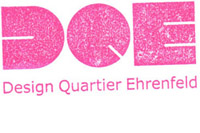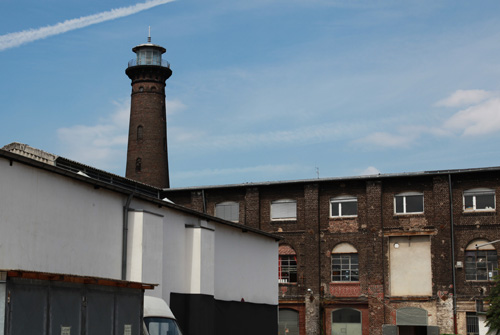
|
|
SABINE VOGGENREITER: CREATIVE CITYSCAPE KÖLN EHRENFELD

As part of the ‚renaissance of cities,‘ an age-old topos reinvents itself: The creative city is back. Under the auspices of an economic structural change and counter to wide-spread assumptions that tangible urban structures are subordinated to global processes, the idea and necessity of complex local infrastructures as urban and socio-spatial milieus are one of the prerequisites for the development of creativity and innovation.
New Urbanity
Innovation happens where creative minds, activists, entrepreneurs, intellectuals, designers, fashion and media designers, architects, artists, students, and artisans become productive within a specific space of social networks and informal processes, in direct interaction and an open, ‚cosmopolitan‘ atmosphere.
Ehrenfeld is such a creative space – a space of creative departure and lifestyles, of local cosmopolitanism, of informal learning, of daily creativity and social interaction. A kind of ‚new urbanity‘ manifests here with participatory structures and ‚bottom-up‘ urban development being the driving forces. Within this district shaped by migrant communities as well as its industrial, artisanal, and working-class character, DQE has set out to develop strategies and concepts for creative practice, with the clear goal of developing the vision of a creative district and finding ways of a participatory rapport with the local community.
‚Bottom-Up‘ City Development
Major themes within this process of development are, among others,
- the ‚conquest‘ and definition as well as repurposing of spaces in the district, both inside and outside
- synergetic use of both working spaces and working facilities
- alternative and communal forms of production
- new models of labour
- ‚bottom-up‘ city development and ‚bottom-up‘-processes in general (i.e. the Productive Cityscape movement)
- cooperations between design and crafts
- networks of knowledge
- co-operative modes of production in urban agriculture and the development of urban brownfields
- communal events directing attention to these phenomena and their necessity of their implementation
A thematic emphasis is on the discourse on creativity and urban development – meaning everyday creativity, ‚community driven projects and processes‘ and especially the transformative effects at the intersections between cultural or creative economy and issues of climate, migration, new forms of labour and urban development.
Creativity and the Quarter
By now, ‚creativity‘ is a task that any city with its eyes set on development will have to face. In the instance of Ehrenfeld, it has proven that creative urban development with regard to urban quarters can be especially dynamic and socially inclusive, as well as facilitate a rapid development of creative processes. Within the context of the quarter, creative processes become particularly visible and allow the synergetic interrelations between creative existences, concepts, and communities to become evident.
In the midst of a district that is both characterized by intercultural exchange as well as traditional and industrial aspects, an ever-growing creative scene thrives, representing a new lifestyle: in favor of an open urban climate and cultural diversity, in favor of sustainability and do-it-yourself, in favor of urban-agrarian models and a new mobility in a quarter that already boasts the most bikers and the least motorists within Cologne’s city limits.
These pioneers of space and founders, these designers, fashion designers, craftsmen, authors, or architects are discovering the urban green as a cityscape that is potentially productive with respect to social, agricultural, climatic and economic issues: a productive cityscape that manages to combine agriculture and subsistence economy with creativity, repurposing, and ‚bottom-up‘ city planning. A trend? Yes, but still relating to the historic fruit- and vegetable-plantations that once made up Ehrenfeld.
Community Made
Further exemplifying the participatory concepts, a number of broadly received events have developed from the exchange of the creative community and DQE in the quarter: the ‚design parcours ehrenfeld‘ as an independent part of the designers’ fair PASSAGEN with as many as 80 events taking place decentrally in Ehrenfeld; its own DESIGNERS FAIR at the Helios-grounds surrounding the DQE hall with over 50.000 international visitors; the design collection UTENSIL originating from Ehrenfeld; the popdesignfestival – pdf; the fashion event MODus; the urban ecological congress ‚Ehrenfelder Frühling‘ (‚Ehrenfeld spring‘) and many more.
Subjects of discussion are the ‚bottom-up‘ development of a creative urban space, urban design, issues of sustainability, permaculture, connections to the history of the quarter, participation of citizens, new worlds of labour, ethics of economies, regional economies, urban restructuring for a climate-friendly mobility, neighborhood, socially creative communities, innovative technologies such as 3D-printers, alternative economies and complying forms of production, green city-planning, degrowth, regional currencies, informal academies, open source planning, commons, or hands-on-urbanism.
Participants are the protagonists of design, media, crafts, and architecture; as well as DQE-scholarshipholders from such fields as ethnology, architecture, economy, botany, art, design, film, politics, and cultural studies.
Creativity and City
DQE is concerned with phenonema of ‚real culture‘ which contribute to the cultural and creative economy becoming the engine of changes in the city and its quarters – particularly in times of crises. It is concerned with the current ‚paradigm shift‘ in which, in the terms of actual processes of cultural production, the creative economy can facilitate an understanding of culture no longer relying on the existence of creative personae and their creative moments, but which instead values processes and chains of production within an ecosystem of creative economy both regarding processes of production and reception. What this entails is an understanding of culture in which the creative economy is taken seriously as a vital agent within the urban economy – in the sense of a sustainable development of vital cities and quarters, in concentrations and clusters.
Design Quartier Ehrenfeld – DQE, the winning project of the European Union-initiated competition Create.NRW realized by the Northrhine-Westphalian ministry of economy, has set out to exemplarily develop Cologne-Ehrenfeld into a dynamic hub of young international and experimental design. With events and workshops concerning relevant new fields of design and quarter-related themes as well as cooperations, agendas for a spatial and contentual restructuring of the Ehrenfeld quarter are conceptualized.
New Labor – Alternative Lifestyles and New Forms of Labor
New Labor: Creatives as Worthy Successors of Craftsmen
The abandoned industrial sites of Ehrenfeld and many of the vacated commercial sites of Alt-Ehrenfeld, the former center of the crafts, have taken in creatives as worthy successors. Both the openness and adaptability of the spaces as well as the small-scale mixture of the various functions of creative work have made the spaces predestined for these uses. A Körnerstraßen-team, for instance, can under one roof combine a commercial space, a workshop, as well as an apartment – in a like-minded and colorful neighborhood with the possibility of direct networks.
New Lifestyle: The Good Life
This atmosphere and this network yield both new ‚alternative‘ styles of life and work as well as new product families, ranging from ecological orientation to rapid prototype production and do-it-yourself-conepts. The value of ideas is higher than that of maximizing profits – self-determined labor and individual production are the parameters here; not just as models for a new style of working, but also for a ‚successful‘ good life. It is no coincidence, then, that the first ‚Day of Good Life‘/Cologne Sunday of Sustainability 2013 took place in Ehrenfeld, a car-less sunday in the quarter providing the freed space to the locals.
In sum, the scene of Ehrenfeld, with its many start-ups and spin-offs, its initiatives, combinations of living and working under one roof, its interdisciplinary networks, alternative products and shops, syndicates and coworking spaces, studios and galleries, is a space of informal learning: a kind of urban academy.
|
|
|